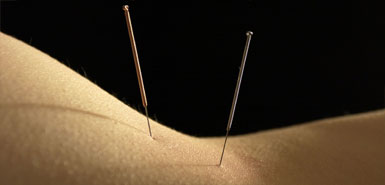Thanks to my wonderful client Ms McLennan for sending me this useful link from TIMESONLINE today regarding acupuncture for chronic back pain. Here is the whole article…

Using acupuncture to help with chronic back pain is more effective than standard treatments alone, a leading scientific study has found.
Trials involving 638 back pain sufferers have suggested that acupuncture is successful in relieving discomfort, although how it works remains unclear. A “fake” version also produced results, indicating that belief in the therapy may have played a key role in its success in this case.
In the project, known as Spine (stimulating points to investigate needling efficacy), patients were divided into groups to receive standard care alone, with one of two variants of genuine acupuncture or with a placebo.
The simulated acupuncture involved mimicking needle pricks using tooth picks hidden inside guide tubes that did not penetrate the skin. Patients were treated twice a week for three weeks and then weekly for a month. At intervals of eights weeks, six months and a year, the researchers measured back pain symptoms and their impact on quality of life.
Both types of genuine acupuncture — either individually tailored or a standardised treatment — produced a substantial improvement in symptoms and the ability of patients to cope with their condition at eight weeks. By contrast, patients on standard care were only slightly better. The beneficial effects lasted for a year, although they waned over time. However, the placebo “toothpick” treatment turned out to be just as good at combating back pain as real acupuncture.
The findings were published yesterday in the journal Archives of Internal Medicine. Daniel Cherkin, the trial leader from the Group Health Centre for Health Studies, in Seattle, said: “We found that simulated acupuncture produced as much benefit as needle acupuncture. That raises questions about how acupuncture works.”
Dr Cherkin said the results had important implications for patients who found conventional treatments ineffective. “The reduction in long-term exposure to the potential adverse effects of medications is also an important benefit that may enhance the safety of conventional medical care,” he said.
Karen Sherman, also a member of the research team, said that, historically, some types of acupuncture have used non-penetrating needles, possibly explaining the success of the placebo treatment.
“We don’t know why people got back pain relief from the simulated acupuncture,” Dr Sherman said. “Maybe the context in which people get treatment has effects that are more important than the mechanical effects.”
At the eight-week stage, 60 per cent of patients receiving any type of acupuncture had a clinically meaningful improvement in their level of functioning, compared with 39 per cent of those receiving regular care.
At the one-year point, 59 to 65 per cent of those in the acupuncture groups experienced an improvement, compared with 50 per cent of the standard care group.
Back pain is the largest single cause of work-related absence in Britain. Lower back pain, also known as lumbago, affects seven out of ten people at some time in their lives.
Josephine Briggs, director of the US National Centre for Complementary and Alternative Medicine, which funded the Spine trial, said: “The findings add to the growing body of evidence that something meaningful is taking place during acupuncture treatments. Future research is needed to delve deeper into what is evoking these responses.”
Alternative therapies
— Willow bark, which contains a chemical similar to aspirin, is a significant help to sufferers of chronic lower back pain, a study published in the American Journal of Medicine found
— Researchers at the University of Sydney found that neither diclofenac, a powerful painkiller, nor spinal manipulative therapy gave any clinically useful effects compared with mild painkillers such as paracetamol
— Cleveland Clinic, an American research hospital, found that patients who listened to music for an hour a day experienced a 20 per cent reduction in back pain
— A folk remedy for back pain suggests finding a dirty rock, spitting on its underside and putting it back where it was found



Leave a Reply
You must be logged in to post a comment.